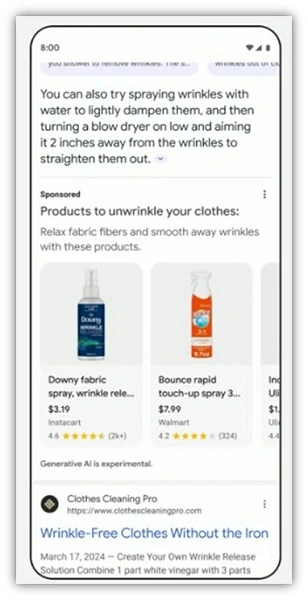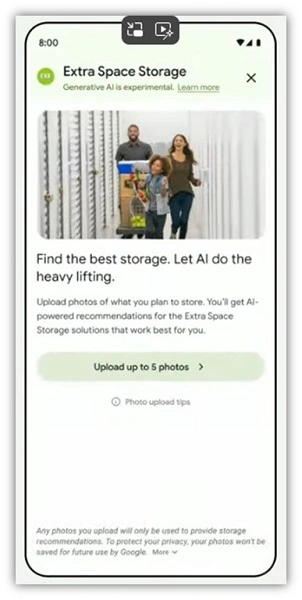Similar to last year, Google Marketing Live provided a torrent of AI-fueled advances for advertisers. In all, nine presenters announced 30 products and features over the 90-minute keynote event.
In the upcoming days and weeks, we’ll examine each of these new products and features in-depth and share what marketers and advertising experts think of them as they roll out.
But for now, here’s a quick recap of the most important announcements from Google Marketing Live 2024.
Contents
8 biggest takeaways from Google Marketing Live 2024
The GML keynote was a fast and furious hour and a half. Here are the biggest announcements from the event.
1. Automatic ad placements in AI overviews
Just last week at Google I/O, Google announced the wider release of AI overviews in search results (formerly known as SGE or search generative experience). Now, Google is testing automatically placed Search, PMax, and Shopping ads in AI Overview boxes.


The ads will show up in a block labeled “Sponsored” to separate them from the organic and AI-derived content.
These ads will show up automatically when they match the intent of both the query and the AI Overview; advertisers don’t need to take any action to target those placements.
2. AI-powered, personalized recommendations and advice
In another experiment, Google is using AI to speed along shoppers’ decision-making process for large or complicated purchases by offering personalized product recommendations.
Google used the example of someone shopping for storage space.
The user would search for “short-term storage” and click on a relevant ad. They would then enter a guided shopping experience where they could answer questions and provide a photo of what they wanted to store.


Google’s AI reviews the details and suggests the right-size storage unit and related items like packing materials. The user then clicks through to a product page on the business’s website to finalize their purchase.
This ad feature is currently in the testing phase. If it’s successful, it will soon be available to other verticals.
3. AI creative asset production for PMax campaigns
Google announced more features and tools to help advertisers create PMax campaign assets faster and at scale. These new features include:
- The ability to add brand guidelines for colors, fonts, and imagery.
- Image editing is used to add and extend backgrounds, add objects, and alter image sizes to fit multiple ad placements (think of adding a plant and expanding the wall for a furniture ad).
- Auto-generation of ads from a product feed.
- Asset-level conversion metrics.


4. AI-enhanced Shopping Ads
Shopping Ads got another layer of AI treatment with several upgrades to create a more immersive shopping experience.
Virtual try-on for apparel
Google is expanding its virtual try-on (VTO) experience to apparel ads. Beginning with men’s and women’s tops, users will be able to see how individual styles look on different body types.
3D product images
Using Adidas brand sneakers as an example, Google showed off new 360-degree shoe views that can be featured in ads. Google generates the 3D images using images provided by the seller.
In-ad, short-form product videos
Advertisers can now incorporate short product videos—created by the brand or by influencers—into ads. The videos will be clickable and interactive, letting shoppers view related products and get styling suggestions.
The ads will include product details under each video.
5. New visually immersive ad formats and features
Google shared that it’s expanding its demand-gen video ad campaigns by adding new options for advertisers. These features include:
- Clickable stickers created from existing image assets.
- The ability for users to swipe left to a branded YouTube landing page.
- AI-generated animations based on static images.
6. Cohesive first-party data management
In a move to improve the quality of data used to guide AI outputs, Google announced that its Ads Data Manager platform is coming out of beta testing and is now widely available.


Ads Data Manager lets advertisers aggregate first-party data from sources like YouTube, Google Ads, HubSpot, and Shopify to make it more visible and actionable. The platform also acts as a “check engine light” to help make sure marketers are using data safely and responsibly.
7. Visual brand profiles on search
Sellers can now create a brand profile for Search, including branded imagery, product deals, videos, and more.
Brand profiles will also include reviews pulled from Product Listing Ads. It remains to be seen how much control advertisers have over which reviews are shown.
8. New profit optimization goals in PMax
Advertisers will be able to optimize ads for profit goals in Performance Max campaigns.
Google says advertisers using the new profit goals saw a 15% uplift in campaign profit compared to revenue-only goals.
What we didn’t see at Google Marketing Live 2024
There was a lot for advertisers to be excited about in this year’s GML keynote, but a couple of topics stood out by their absence.
No B2B-specific products or features
Once again, the 90-minute Google Marketing Live session focused on the rollout of products designed to help business-to-consumer brands generate more return from their Google Ads investments.
There wasn’t a single mention of a B2B company, example, or use case. For obvious reasons, we’d have loved to see some.
No (or too few) small-business case studies
By number, the vast majority of advertisers on Google are small businesses. Yet just about every example, case study, and customer story featured big brands using Google’s newest features to attract new customers.
Additionally, the majority of example use cases for the new features announced at Google Marketing Live 2024 were for travel and ecommerce–industries that typically thrive in the search ads environment. Meanwhile, the typical small business wouldn’t be able to reap the same benefits from these new features.
“Google Ads and YouTube ads for well-established brands should work. If it didn’t, it would be alarming. Show me a local business with impressive stats,” tweeted Julie Bacchini, President of Neptune Moon and Managing Director of PPCChat.


Our hope is that Google will use AI to make advertising easier for smaller businesses with smaller budgets.
What it all means
We’ll dig deeper into all these announcements and new AI features in an upcoming post, but for now, the takeaway is clear: Google is investing heavily in AI across the board. We get the feeling that not all users are quite as excited about AI as Google is, and regardless, there are bound to be some hiccups, as with any new technology. But we’ll be here to help you all navigate the changes.